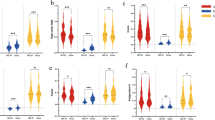Abstract
The purpose of this study is to analyze the repeatability and agreement of corneal power using a new Hartman type topographer in comparison to Scheimpflug+Placido and autorefractor devices. In this cross sectional, observational study performed at the cornea services of a specialty hospital, 100 normal eyes (100 consecutive candidates) without any previous ocular surgery or morbidity except refractive error were evaluated. All candidates underwent three measurements each on a Full gradient, Hartman type topographer (FG) (iDesign, AMO), Scheimpflug+Placido topographer (SP) (Sirius, CSO) and rotating prism auto-keratorefractor (AR) (KR1, Nidek). The parameters assessed were flat keratometry (K1), steep keratometry (K2), steep axis (K2 axis), mean K, J 0 and J 45. Intra-device repeatability and inter-device agreement were evaluated. On repeatability analysis, the intra-device means were not significantly different (ANOVA, p > 0.05). Intraclass correlations (ICC) were >0.98 except for J 0 and J 45. In terms of intra-measurement standard deviation (Sw), the SP and FG groups fared better than AR group (p < 0.001, ANOVA). On Sw versus Average plots, no significantly predictive fit was seen (p > 0.05, R 2 < 0.1 for all the values). On inter-device agreement analysis, there was no difference in means (ANOVA, p > 0.05). ICC ranged from 0.92 to 0.99 (p < 0.001). Regression fits on Bland–Altman plots suggested no clinically significant effect of average values over difference in means. The repeatability of Hartman type topographer in normal eyes is comparable to SP combination device and better than AR. The agreement between the three devices is good. However, we recommend against interchanging these devices between follow-ups or pooling their data.







Similar content being viewed by others
References
Swartz T, Marten L, Wang M (2007) Measuring the cornea: the latest developments in corneal topography. Curr Opin Ophthalmol 18:325–333
Oliveira CM, Ribeiro C, Franco S (2011) Corneal imaging with slit-scanning and Scheimpflug imaging techniques. Clin Exp Optom 94:33–42
Crawford AZ, Patel DV, McGhee CN (2013) Comparison and repeatability of keratometric and corneal power measurements obtained by Orbscan II, Pentacam, and Galilei corneal tomography systems. Am J Ophthalmol 156:53–60
Tajbakhsh Z, Salouti R, Nowroozzadeh MH et al (2012) Comparison of keratometry measurements using the Pentacam HR, the Orbscan IIz, and the TMS-4 topographer. Ophthalmic Physiol Opt 32:539–546
Menassa N, Kaufmann C, Goggin M et al (2008) Comparison and reproducibility of corneal thickness and curvature readings obtained by the Galilei and the Orbscan II analysis systems. J Cataract Refract Surg 34:1742–1747
Savini G, Carbonelli M, Sbreglia A et al (2011) Comparison of anterior segment measurements by 3 Scheimpflug tomographers and 1 Placido corneal topographer. J Cataract Refract Surg 37:1679–1685
Savini G, Barboni P, Carbonelli M, Hoffer KJ (2011) Repeatability of automatic measurements by a new Scheimpflug camera combined with Placido topography. J Cataract Refract Surg 37:1809–1816
Miller D, Thall EH, Atebara NH (2004) Ophthalmic Instrumentation. In: Yanoff M, Duker JM (eds) Ophthalmology, 3rd edn. Elsevier, Philadelphia, pp 77–78
Klein SA (1997) Corneal topography reconstruction algorithm that avoids the skew ray ambiguity and the skew ray error. Optom Vis Sci 74:945–962
Klein SA (1997) Axial curvature and the skew ray error in corneal topography. Optom Vis Sci 74:931–944
Savini G, Calossi A, Camellin M et al (2014) Corneal ray tracing versus simulated keratometry for estimating corneal power changes after excimer laser surgery. J Cataract Refract Surg 40:1109–1115
Karnowski K, Kaluzny BJ, Szkulmowski M, Gora M, Wojtkowski M (2011) Corneal topography with high-speed swept source OCT in clinical examination. Biomed Opt Express 2:2709–2720
Jhanji V, Yang B, Yu M, Ye C, Leung CK (2013) Corneal thickness and elevation measurements using swept-source optical coherence tomography and slit scanning topography in normal and keratoconic eyes. Clin Exp Ophthalmol 41:735–745
Mejía Y, Galeano JC (2009) Corneal topographer based on the Hartmann test. Optom Vis Sci 86:370–381
Zhou F, Hong X, Miller DT, Thibos LN, Bradley A (2004) Validation of a combined corneal topographer and aberrometer based on Shack-Hartmann wave-front sensing. J Opt Soc Am A Opt Image Sci Vis 21:683–696
Stevens JD (2009) Using next-generation topography to screen LASIK candidates. Cataract and Refractive surgery Today Europe. March, 2009. http://bmctoday.net/crstodayeurope/2009/03/article.asp?f=0309_05.php. Accessed 10 Dec 2014
Topcon medical systems: KR-1 product brochure. http://www.topconmedical.com/products/kr1-literature.htm. Accessed 10 Dec 2014
Thibos LN, Wheeler W, Horner D (1997) Power vectors: an application of Fourier analysis to the description and statistical analysis of refractive error. Optom Vis Sci 74:367–375
Bland JM, Altman DG (1996) Measurement error. BMJ 313:744
Wang Q, Savini G, Hoffer KJ et al (2012) A comprehensive assessment of the precision and agreement of anterior corneal power measurements obtained using 8 different devices. PLoS One 7:e45607
Módis L Jr, Szalai E, Kolozsvári B et al (2012) Keratometry evaluations with the Pentacam high resolution in comparison with the automated keratometry and conventional corneal topography. Cornea 3:36–41
Visser N, Berendschot TT, Verbakel F, de Brabander J, Nuijts RM (2012) Comparability and repeatability of corneal astigmatism measurements using different measurement technologies. J Cataract Refract Surg 38:1764–1770
Shetty R, Arora V, Jayadev C, Nuijts RM, Kumar M, Puttaiah NK, Kummelil MK (2014) Repeatability and agreement of three Scheimpflug-based imaging systems for measuring anterior segment parameters in keratoconus. Invest Ophthalmol Vis Sci 29:5263–5268
Conflict of interest
None of the authors have any financial interests in the products and techniques described in the manuscript and lack thereof.
Author information
Authors and Affiliations
Corresponding author
Rights and permissions
About this article
Cite this article
Prakash, G., Srivastava, D. & Choudhuri, S. A novel Hartman Shack-based topography system: repeatability and agreement for corneal power with Scheimpflug+Placido topographer and rotating prism auto-keratorefractor. Int Ophthalmol 35, 869–880 (2015). https://doi.org/10.1007/s10792-015-0065-7
Received:
Accepted:
Published:
Issue Date:
DOI: https://doi.org/10.1007/s10792-015-0065-7




